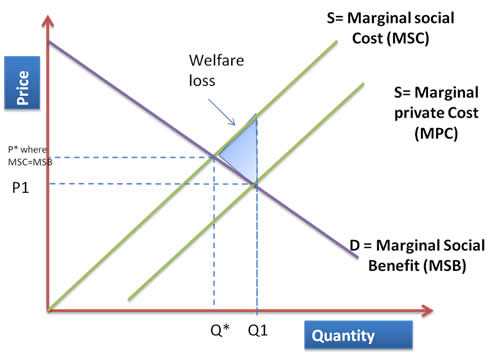What is Production Externality?
Production externality refers to the impact that a firm’s production activities have on third parties or the surrounding environment, which is not reflected in the firm’s costs or revenues. It occurs when the production of a good or service by one firm affects the well-being of others in a positive or negative way.
Positive production externality occurs when the production of a good or service by a firm benefits third parties or the society as a whole. For example, when a factory installs pollution control measures to reduce emissions, it not only improves the air quality for the surrounding community but also reduces healthcare costs and improves the overall well-being of the residents.
On the other hand, negative production externality occurs when the production of a good or service by a firm imposes costs on third parties or the society. For instance, when a factory emits pollutants into the air or water, it can harm the health of nearby residents, damage ecosystems, and decrease property values.
External Costs and Benefits

Production externality leads to the existence of external costs or benefits. External costs are the costs imposed on third parties or the society due to the production activities of a firm. These costs are not borne by the firm itself and are not reflected in its production decisions. Examples of external costs include pollution, noise, congestion, and health problems.
External benefits, on the other hand, are the benefits received by third parties or the society as a result of a firm’s production activities. These benefits are not captured by the firm and are not considered in its decision-making process. Examples of external benefits include job creation, technology spillovers, and improved infrastructure.
Conclusion
How is Production Externality Measured?
Measuring production externality is a complex task that requires careful analysis and consideration of various factors. There are several methods and approaches used to measure production externality, each with its own advantages and limitations.
One common method is the use of economic models, such as cost-benefit analysis or input-output analysis. These models help economists quantify the costs and benefits associated with production externality. By comparing the social costs and private costs of production, economists can estimate the magnitude of the externality.
Another approach is the use of surveys and interviews to gather data on the impacts of production externality. This method involves collecting information from affected individuals and communities to assess the extent of the externality and its effects on their well-being. Surveys can provide valuable insights into the social and environmental costs of production, allowing policymakers to make informed decisions.
Additionally, some researchers use statistical analysis to measure production externality. They analyze data on production levels, pollution levels, and other relevant variables to identify the relationship between production activities and external costs. This approach helps quantify the impact of production on the environment and society.
It is important to note that measuring production externality is not an exact science. There are inherent challenges and limitations in capturing the full extent of external costs. Factors such as data availability, measurement errors, and the complexity of externalities make it difficult to obtain precise measurements.
Despite these challenges, measuring production externality is crucial for effective policy-making and sustainable development. It provides policymakers with valuable information to design and implement appropriate regulations and incentives to mitigate the negative impacts of production activities.
Real-World Examples of Production Externality
Production externality occurs when the production of a good or service by one party affects the well-being of other parties who are not directly involved in the production process. This can result in positive or negative externalities, depending on the impact it has on these third parties.
Example 1: Pollution from Industrial Production
One of the most common examples of negative production externality is pollution caused by industrial production. When factories release harmful pollutants into the air or water, it can have adverse effects on the environment and the health of nearby communities. These external costs are not borne by the producers themselves but are instead imposed on society as a whole.
Example 2: Noise Pollution from Construction
Construction activities can also create negative production externality in the form of noise pollution. The loud noises generated by construction machinery and equipment can disrupt the peace and quiet of nearby residential areas. This can lead to decreased quality of life for the residents and potential health issues, such as stress and sleep disturbances.
Example 3: Positive Externalities from Education
Not all production externalities are negative. Education is a prime example of a positive production externality. When individuals receive education, they not only benefit themselves but also contribute to the overall development and well-being of society. Educated individuals are more likely to secure higher-paying jobs, contribute to innovation and economic growth, and make informed decisions as citizens.

Emily Bibb simplifies finance through bestselling books and articles, bridging complex concepts for everyday understanding. Engaging audiences via social media, she shares insights for financial success. Active in seminars and philanthropy, Bibb aims to create a more financially informed society, driven by her passion for empowering others.
